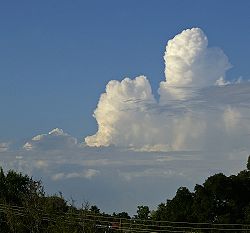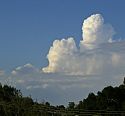Velum (forma chmury)

velum (vel) (łac. żagiel, zasłona, firanka) – forma chmury poziomej towarzysząca chmurom Cumulus i Cumulonimbus. Znajduje się nad wierzchołkiem chmur kłębiastych lub przylega do niego, a gdy chmura macierzysta przebije ją (co zazwyczaj się dzieje) − może przylegać do jej środkowej albo dolnej części. Chmury velum w przeciwieństwie do chmur pileus powstają w warstwie stabilnego, wilgotnego powietrza unoszonego przez prądy konwekcyjne wewnątrz głównej chmury. Mogą one istnieć nawet, gdy chmura macierzysta zanika.
Bibliografia
- Richard Hamblyn: Wielka księga chmur. Warszawa: Wydawnictwo RM, 2010, s. 112. ISBN 978-83-7243-808-9.
- Międzynarodowy Atlas Chmur, Państwowy Instytut Hydrologiczno-meteorologiczny, 1956
Media użyte na tej stronie
Autor: Dwindrim (dyskusja · edycje), Licencja: CC BY-SA 1.0
This sky has "nice day" written all over it. The cumulus humilis indicates very little convection in the lower atmosphere, and the fact that it is well-formed indicates light winds at low levels. There is no cloud aloft, and thus no moisture or stable conditions or both. The cumulus congestus on the horizon suggests showers may be possible three or four hours from now, at the earliest, but chances are good it will remain a pleasant day through until the evening. The azure blue is typical of Alberta's clear, dust/haze/pollution-free skies.
Autor: Bidgee, Licencja: CC BY-SA 3.0
A example of Cumulus congestus which is known as towering cumulus.


